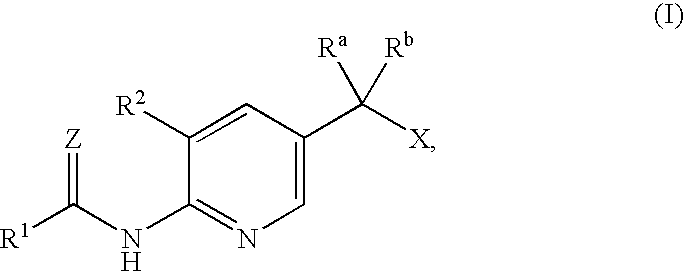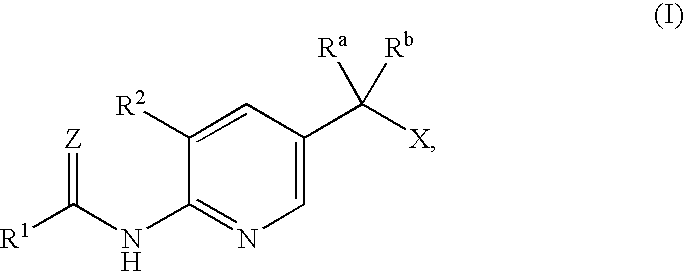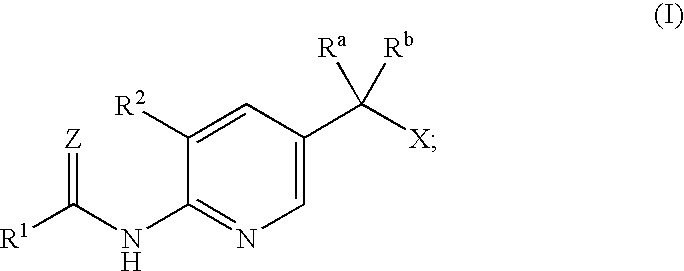Anti-diabetic agents
a technology of anti-diabetic agents and active ingredients, applied in the field of anti-diabetic agents, can solve the problems of ineffectiveness of agents with a particular patient, inability to treat diabetes, and side effects of hypoglycemic agents,
- Summary
- Abstract
- Description
- Claims
- Application Information
AI Technical Summary
Problems solved by technology
Method used
Image
Examples
preparation 1
[0087]2-(5-Ethoxy-6-nitro-pyridin-3-yl)-2-hydroxy-propionic acid ethyl ester
[0088]A solution of 3-ethoxy-2-nitro-pyridine (8.95 g) and ethyl 2-chloropropionate (21.8 g) in DMF (85 mL) was added dropwise to a slurry of sodium hydride (6.38 g, 60% suspension in oil) in DMF (85 mL) while cooling at 0–5° C. The resulting purple-colored solution was stirred at 0–5° C. for one hr., and then at room temperature for two hrs. Benzaldehyde (8.4 g) was added, and then dry air was bubbled into the reaction mixture overnight. The reaction mixture was poured onto a mixture of 1N aqueous hydrogen chloride (200 mL), ice (200 mL), and EtOAc (400 mL). The phases were separated and the organic phase was washed with water, 1N aqueous sodium hydroxide (150 mL), water, and brine. After drying over magnesium sulfate and filtration, the solvent was evaporated. The resulting liquid was triturated with hexanes to afford 15 g of a red oil which was purified by flash chromatography on silica gel, eluting with ...
preparation 2
[0089]2-(6-Amino-5-ethoxy-pyridin-3-yl)-2-hydroxy-propionic acid ethyl ester
[0090]A mixture of 2-(6-nitro-5-ethoxy-pyridin-3-yl)-2-hydroxy-propionic acid ethyl ester (1.3 g), ammonium formate (1.5 g), and 10% Pd / C (100 mg) was stirred in a 1:1 mixture of THF / methanol overnight. The reaction mixture was filtered through diatomaceous earth, and the filtrate evaporated to yield an oil. The oil was dissolved in EtOAc, washed with water and brine, and the organic layer separated and dried over magnesium sulfate. Evaporation furnished 863 mg of the title compound. LC / MS+=255.
preparation 3
[0091]2-(5-Ethoxy-6-nitro-pyridin-3-yl)-2-methyl-propionic acid ethyl ester
[0092]A solution of 3-ethoxy-2-nitro-pyridine (0.84 g) and ethyl 2-chloropropionate (2.1 g) in DMF (8 mL) was added dropwise to a slurry of sodium hydride (0.6 g, 60% suspension in oil) in DMF (8 mL) while cooling at 0–5° C. The resulting purple-colored solution was stirred at 0–5° C. for one hr., and then at room temperature for two hrs. Dimethylsulfate (0.89 g) was added to the solution and the reaction mixture was shaken overnight. The resulting amber-colored solution was poured onto a mixture of 1N aqueous hydrogen chloride (20 mL), ice water (20 mL), and EtOAc (50 mL), and the phases were separated. The organic phase was washed with 1N aqueous sodium hydroxide, water, and brine. The solvent was evaporated to give an amber-colored oil (933 mg), which was purified by flash chromatography on silica gel, eluting with 1:4 ethyl acetate / hexanes to give 389 mg (28% yield) of a pale yellow oil. AP / MS+=283.
PUM
| Property | Measurement | Unit |
|---|---|---|
| mass | aaaaa | aaaaa |
| temperature | aaaaa | aaaaa |
| cell density | aaaaa | aaaaa |
Abstract
Description
Claims
Application Information
 Login to View More
Login to View More - R&D
- Intellectual Property
- Life Sciences
- Materials
- Tech Scout
- Unparalleled Data Quality
- Higher Quality Content
- 60% Fewer Hallucinations
Browse by: Latest US Patents, China's latest patents, Technical Efficacy Thesaurus, Application Domain, Technology Topic, Popular Technical Reports.
© 2025 PatSnap. All rights reserved.Legal|Privacy policy|Modern Slavery Act Transparency Statement|Sitemap|About US| Contact US: help@patsnap.com



